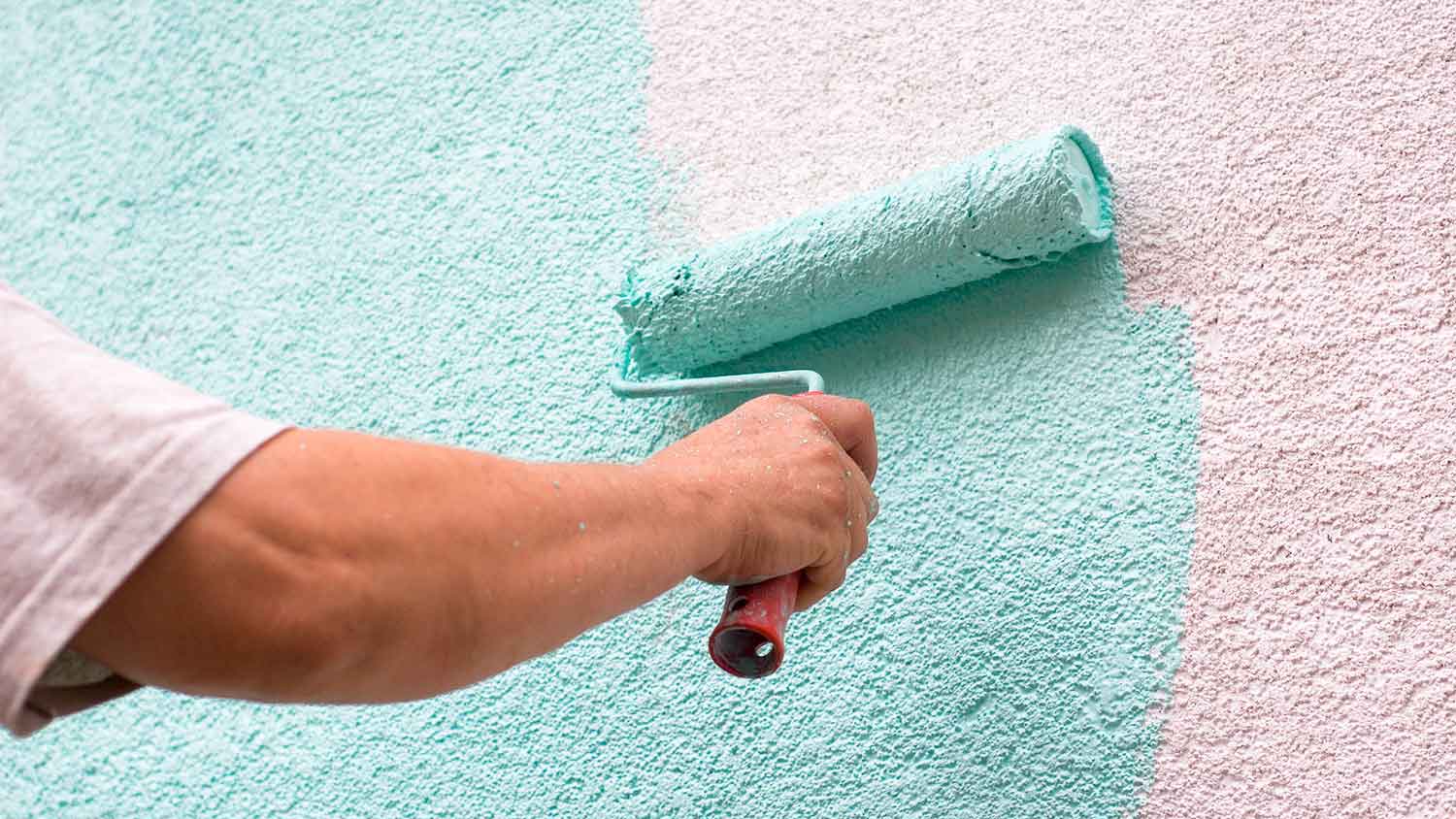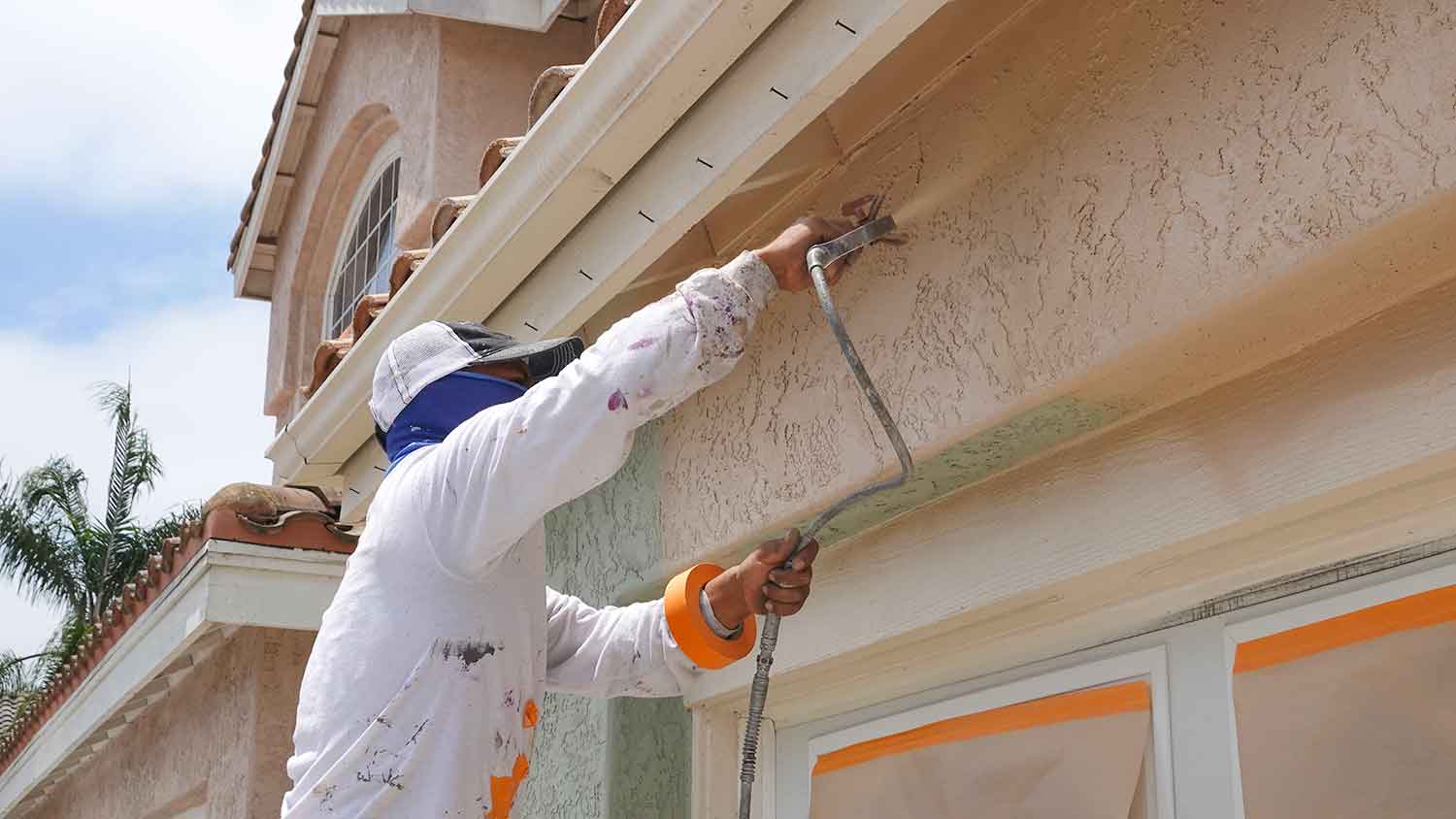The Best Paint for Stucco House Exteriors
Choosing the right paint can significantly extend the life span of your stucco


Stucco lends a beautiful texture to the outside of your home—as long as you maintain it correctly. Paint your stucco every five to 10 years using the right paint to keep your home protected against the elements while looking great at the same time.
Whether you’re in one of the hotter regions of the U.S., like the Southwest, or in an area that gets colder and has a proper winter, you need a paint that meets your needs and budget. Let's look at a few of the best paints for stucco.

Acrylic

In settings that don’t get a lot of rainfall, 100% acrylic latex paint is the best paint for stucco because it checks the boxes mentioned above: It’s durable, breathable, and flexible. Acrylic paint is one of the easiest paints to work with, and it dries quickly—the downside is that you might not have time to go back to fix mistakes, but you can just paint over them.
If you’re concerned about the cost to paint a stucco house, then acrylic tends to be the most affordable option, costing $20 to $50 per gallon on average. Acrylic latex paint is also widely available at any home improvement store.
Pros
Durable
Breathable
Flexible
Widely available
Easy to work with
Relatively affordable
Wide range of colors
Eco-, kid-, and pet-friendly
Can last five to 10 years on properly prepared stucco surfaces
Cons
Dries very quickly
Doesn’t adhere to stucco as well as elastomeric or masonry paint
Not as waterproof as elastomeric paint
Elastomeric

As the name suggests, elastomeric paint has elastic, flexible properties. Elastomeric paint is applied as a liquid and dries into a rubber coating on your stucco. It’s probably no surprise that elastomeric paint’s rubbery quality makes it a great choice as a waterproofing paint. Still, it takes much longer to dry than other paints—about 72 hours—and it’s not exceptionally breathable. Elastomeric paint costs $35 to $50 per gallon on average.
Pros
Water-resistant
Can fill and cover hairline cracks in stucco
May last up to seven years longer than acrylic when applied to properly prepared stucco surfaces
Cons
Limited color selection
Can take up to 72 hours to completely cure
Not very breathable and can trap moisture in the stucco
Lack of breathability can lead to mold and mildew problems as well as deterioration in freeze/thaw cycles
Can be more costly than acrylic paints
More labor-intensive to apply and should be done by a professional painter
Can only repaint with another coat of elastomeric paint
When applied over multiple layers of paint, the weight can cause older paint to delaminate
Masonry

Masonry paints are formulated to adhere well to surfaces like concrete, brick, cement blocks, and stucco. Its strengths include high durability and resistance to moisture and mildew. You can find masonry paints at most home improvement stores. However, the color selection is limited.
Masonry paint is a good choice if you can find the color you want because it combines the best qualities of acrylic paint and elastomeric paint. The cost also lands between acrylic and elastomeric. Masonry paint costs $25 to $50 per gallon.
Pros
Durable yet flexible
Bonds strongly to stucco
High moisture and mildew resistance
Relatively easy to find
Cons
Limited color selection
The same quantity covers less area than acrylic paints
Why Does the Paint Type Matter?
Although stucco doesn’t need paint on top of its finish coat, topping stucco siding or veneer with two coats of paint is a best practice, just like with aluminum or vinyl siding. The best type of paint for stucco is durable and adheres well.
It also needs to interact appropriately with moisture, being waterproof from the outside but allowing vapors to escape from the inside without blistering or peeling. And, of course, the paint you use on your stucco home should be as low maintenance as possible.
DIY vs. Hiring a Professional Painter
Acknowledging the intricacies and expertise required to paint stucco's rough and uneven surface compared to other siding materials is essential when deciding to DIY or hire a pro.
The coarse and porous nature of stucco can cause paint to adhere or absorb unevenly, resulting in an unsightly finish. Also, damaged stucco surfaces must be addressed before painting, requiring meticulous preparation.
If you're contemplating a DIY endeavor, conduct thorough research to understand the complexities involved fully.
For optimal results and to safeguard your investment, it's advisable to seek the services of a skilled professional exterior painter. Their experience and specialized tools can prevent potential damage, deliver high-quality work, and save you time and money.
Cost to Paint Stucco
The typical cost to paint a stucco house falls between $3,600 and $7,200, with an average national cost of $4,500.
The primary factors influencing this cost are the size of your home and the type of paint you choose for the project. For example, elastomeric paint, the gold standard for stucco known for its remarkable resilience and 10-year lifespan, can drive your total expenditure up to $8,500 for a 2,000-square-foot home.
Lastly, remember that damaged stucco will require repairs before painting, adding to your out-of-pocket costs.
Josh Maday contributed to this piece.
Frequently Asked Questions
The longevity of paint on stucco surfaces depends on climate conditions, the quality of the paint used, and the level of maintenance. A well-applied coat of paint can last five to 10 years on stucco exteriors. Stucco's textured and porous nature can make it prone to wear and weathering, especially in extreme temperature fluctuations or high humidity.
To extend the life span of stucco paint, routine cleaning, inspections for cracks or peeling, and timely touch-ups are recommended. High-quality paint and proper surface preparation can create a longer-lasting and vibrant finish.
Choosing between spraying or rolling paint on stucco surfaces depends on various factors. Spraying paint can be faster and more efficient, covering large areas quickly and evenly, especially for smoother surfaces. However, rolling paint offers better control and precision and pushes paint more effectively into cracks and crevices, but it takes longer, making it better for smaller projects.
Ultimately, the decision depends on the specific stucco texture, project size, and personal preferences. Some professionals even combine both techniques for optimal results, tailoring the approach to the unique characteristics of each stucco surface.
Painting over stucco is a great idea when done correctly. It provides an opportunity to refresh and protect the exterior, improving a home's curb appeal. Moreover, it adds a protective layer against the elements, preventing moisture infiltration and reducing the risk of stucco damage.
However, proper preparation, including cleaning, repairing cracks, and applying the appropriate primer, is crucial for a successful outcome. Using high-quality paint is also essential for long-lasting results. When done with care and attention to detail, painting over stucco can be a cost-effective way to transform and maintain your home's exterior.





- Can You Paint Stucco? Here’s Everything You Need to Know
- Stuck on Stucco? 6 Stucco Maintenance Tips to Increase Its Life Span
- The Pros and Cons of Stucco Siding for Your Home
- What Is the Best Exterior Paint? Here Are the Top 6 Choices
- What is Stucco Siding? And How Is It Used in Homebuilding?
- Top Questions to Ask a Stucco Contractor
- Who to Call for Stucco Repair
- How Much Does a Gallon of Paint Weigh?
- How Long Does Paint Last, and How Can You Tell If It’s Expired?
- Types of Paint: Which Is Best for Your Project?










